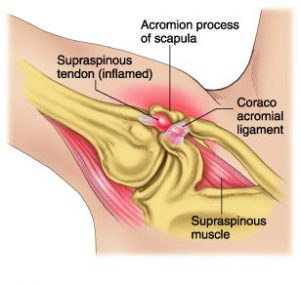What is Shoulder Impingement?
Shoulder impingement is a condition of which the shoulder’s bursa sac and / or rotator cuff tendons become pinched and compressed causing them to become inflamed therefore resulting in pain with motions specifically involving elevation of the shoulder.

Zone of Shoulder Impingement (Subacromial Space)
The zone of shoulder impingement refers to the space under the joint where the collarbone and the shoulder blade come together (AC joint) and above the humerus (shoulder bone). This space is also referred to as the subacromial space.
In normal shoulder function the head of the humerus (which looks like a ball) remains seated in the socket of the scapula (shaped like a cup) during all movement, allowing for the shoulder to elevate within the cup therefore preventing compression of the tendons that travel through the subacromial space.
The rotator cuff muscles are the primary stabilizers of the shoulder joint and control elevation of the shoulder by contracting to stabilize the humeral head (ball) inside of the scapula (cup) during movement. Due to weaknesses or muscular imbalances the movement pattern of the shoulder can become faulty and result in upward translation of the humeral head (ball) which can result in pinching of the tendons that exist in the subacromial space (zone of impingement).
When these tendons are repeatedly compressed or pinched it can result in inflammation causing shoulder bursitis (inflammation of the bursa) and/or tendonitis (inflammation of the tendons – most commonly the rotator cuff tendons).
Signs of Shoulder Impingement
The most common presentation of shoulder impingement includes:
· Pain with reaching behind head or back
· Pain when reaching across body
· Painful arc when raising arm out to the side when at shoulder height or overhead
· Pain at rest (as condition progresses)
· Weakness noted with reaching or lifting overhead
Who gets Shoulder Impingement?
Shoulder impingement occurs most commonly in individuals who participate in repetitive overhead activities above shoulder height such as throwing athletes, electricians, mechanics, swimmers and weight lifters.
Importance of the Rotator Cuff
The rotator cuff is a group of four muscles that work in conjunction with each other to maintain the position of the shoulder in the socket. In other words the rotator cuff works to keep the ball of the humerus bone inside of the cup of the socket. With good rotator cuff functioning it works to prevent injuries including impingement, subluxations and dislocations.
Types of Shoulder Impingement
· Primary Impingement (structural narrowing)
Primary impingement occurs when the subacromial space (space where the rotator cuff tendons and bursa sit) is anatomically more narrow than typical. Some conditions causing the narrowing include arthritis and bone spurs, which occupy space in this area resulting in less space for the rotator cuff to exist without compression.
· Secondary Impingement (dynamic instability)
Secondary Impingement occurs when there is a combination of excessive joint laxity, ligamentous laxity and muscular weakness / imbalances surrounding the shoulder joint. As a result the ball of the shoulder joint tends to ride upwards more excessively and does not stay in the cup of the socket. As a result of the excessive elevation risk of compressing the rotator cuff / bursa increases dramatically, resulting in impingement. This condition is most commonly seen in overhead athletes.
Managing Impingement
· Rest and Ice
· Postural awareness
· Rotator cuff and postural strengthening
· Stabilization of shoulder and core
· Seek conservative treatment (physical therapy) sooner rather than later before condition progresses
Resources:
Miller, J., and Z. Russell. “Shoulder Impingement.” Physioworks, 30 June 2019. Physioworks.com.au/injuries-conditions-1/rotator-cuff-impingement.
https://www.pinterest.com/pin/370632244315951981/

